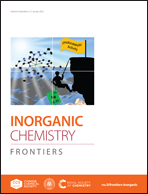New iron(ii) spin-crossover metallomesogen with long aliphatic chain terminated by a C![[double bond, length as m-dash]](https://www.rsc.org/images/entities/char_e001.gif) C bond†
C bond†
Abstract
Spin-crossover (SCO) molecules have been proposed for applications in molecular spintronic devices due to their bistability which can be reversibly switched by an external stimulus. Here, we report the synthesis, structure and characterization of an Fe(II) complex, FeL2 (L = N′-(pyridin-2-ylmethylene)-4-(undec-10-en-1-yloxy)benzohydrazide), having long aliphatic chains with terminal C![[double bond, length as m-dash]](https://www.rsc.org/images/entities/char_e001.gif) C bonds. Variable-temperature Single Crystal X-ray Diffraction (SCXRD) and magnetic susceptibility measurements reveal that the SCO behavior with a thermal hysteresis loop originates from the combination of the change of the Fe(II) center coordination environment and the thermal motion of long aliphatic chains. Differential Scanning Calorimetry (DSC), variable-temperature Powder X-ray Diffraction (PXRD) and Polarized Optical Microscopy (POM) measurements suggest that the latter is also associated with a crystal–liquid crystal (LC) phase transition at high temperatures. Together, these results provide the prerequisites for potential applications of bistable SCO molecules in spintronic devices and liquid crystal displays.
C bonds. Variable-temperature Single Crystal X-ray Diffraction (SCXRD) and magnetic susceptibility measurements reveal that the SCO behavior with a thermal hysteresis loop originates from the combination of the change of the Fe(II) center coordination environment and the thermal motion of long aliphatic chains. Differential Scanning Calorimetry (DSC), variable-temperature Powder X-ray Diffraction (PXRD) and Polarized Optical Microscopy (POM) measurements suggest that the latter is also associated with a crystal–liquid crystal (LC) phase transition at high temperatures. Together, these results provide the prerequisites for potential applications of bistable SCO molecules in spintronic devices and liquid crystal displays.
![Graphical abstract: New iron(ii) spin-crossover metallomesogen with long aliphatic chain terminated by a C [[double bond, length as m-dash]] C bond](/en/Image/Get?imageInfo.ImageType=GA&imageInfo.ImageIdentifier.ManuscriptID=D1QI01181B&imageInfo.ImageIdentifier.Year=2022)


 Please wait while we load your content...
Please wait while we load your content...
![[double bond, length as m-dash]](https://www.rsc.org/images/entities/h2_char_e001.gif) C bond
C bond